The
proposal for this project was born out of an initial idea (a
film about town centres) that seemed, at the time, too big and
perhaps lacked the artistic merit that I was looking for. Time
spent on this initial idea was not wasted; key concepts very
close to my own feelings about film and art emerged.
There were three important key things arising from my sketchbooks.
The first was my interest in the 1970s 3-D ‘View Masters’
toy. In wanting to look at my subject matter in a different
way I studied what happens to the internal picture movement
of a View Master picture when you clicked the button. I wanted
to work this into the beginning of my film and also use the
sound of the button clicking – each click signifying the
beginning of a new world.

The
second area was the box that I constructed for this project.
This box, initially, was designed to help me conceive how my
Audio and Video piece would be shown. It was to be a sort of
model stage designed for holding relevant material and subject
matter. This box was influenced heavily by the ‘Valise’
(suitcase) artworks created by Marcel Duchamp (1897 –
1968). I will return to this important influence later.
There was no third item or object but rather the connection
between the first two. As the deadline for this proposal approached
I began to lose interest in my initial idea, and therefore entered
into dialogue with colleagues, peers and friends. What came
out of these discussions was a link to my childhood.
When asked why I was using the ‘View Master’ I replied,
“Growing up in Belfast in the 70s and 80s didn’t
offer me many beautiful views (apart from the landscape of rural
Ireland). When I looked into the View Master it was like windows
to other worlds.” People seemed to like this link and
advised that I should capitalise on its significance.
My
sketchbooks and box came under the microscope. When asked why
I kept so many sketchbooks and why I went to great lengths to
make a ‘stage’ for my audio and video piece I answered,
“I always have – a sort of aid to help me understand
things in a better way.” In contrast to the way I am now,
as a child I was very withdrawn, enjoyed my own company and
therefore spent lots of time creating ‘mini’ books
and odd boxes. This appropriation of size was very important
to me. I did not care much for my real environment and thus
created my own. To this day, I realise that this isolation affects
the way in which I work and try to understand art.
At this point my proposal began to take shape. My main interest
in this MA in Computer Arts was the ‘Arts’ bit.
What is Art today? What does it mean for me and how can I engage
with it? As a practitioner and teacher of Graphic Design, 20th
Century Art and Design History has been an area that I have
studied for some time. Conceptual Art has been the one area
that has intrigued me the most, especially the work of Marcel
Duchamp. Morgan & Welton, in their excellent book ‘See
What I Mean?”, described Conceptual Art as, ‘…emphasising
content at the expense of form: what matters is not the specific
object produced by the artist, but the processes by which it
was produced’ (p92). With this in mind I decided to try
record my working processes, combining audio and video inside
the box that I had created. Before this point, the box was just
a by-product or back-up piece. The question was, ‘How
could I put a film in the box?’
Influences
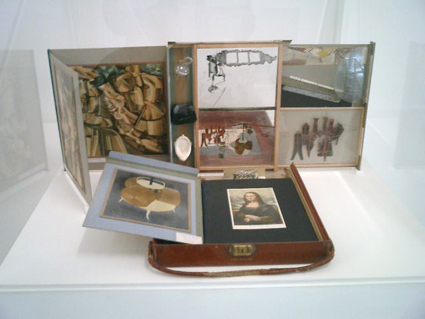
Marcel
Duchamp made 21 Valise boxes creating 71 hand made miniatures
of his artworks to go inside. This painstaking process must
have been very difficult and could be interpreted as a reaction
to rejection by galleries and artists of his time. Lack of acceptance
into the pack did not stop Duchamp – he created his own
gallery in his suitcase collections. Unwilling to compromise
his beliefs Duchamp seems to me an admirable character.

Susan
Hiller’s (1940 - ) ‘From the Freud Museum’
is a sort of anthropological installation that attracted me
when I first saw it in the Tate Modern in 2004. It is a series
of boxes that contain objects, writings and images about mythology,
history, religion, comedy, etc. that tells stories about different
places and happenings around the world. There is one called
‘FATLAD’, an acronym for the six counties of Northern
Ireland: very sharp and well observed. One of the boxes has
a small screen embedded inside, called ‘Séance
(seminar)’. Hiller uses this box to collect shadows, which
she has appearing in a loop on this small screen. This embedded
film seemed very powerful and gave me the confidence to pursue
similar opportunities.

Bill
Viola (1951 - ), a leading video artist, created a video installation
piece in 1992 called ‘Nantes Triptych’ that uses
three screens. One shows the birth of his child, the middle
one is Viola himself suspended in water and the last shows the
death of his mother. Extremely powerful and thought provoking,
this piece borrows from the traditional Renaissance style of
framing. The number three occurs in many artworks as well as
in literature. Dante Alighieri (1265 - 1321) wrote the ‘Divine
Comedy’ in which the number three is at the very centre
of the construct (three books, a rhyming scale of three, etc.).
The use of this mystical number three has interested me in the
past and indeed I would like it to feature in my video and audio
work.
(See past works on my web space:
http://www.paulglennon.co.uk/art_og/iii.html)
Concept
With all these factors collected I began to build some sort
of proposal. My first step was to get a film inside my box.
Recently I showed my tutor (Mike Barker) a short film I made
entitled ‘Lecturer’s Lunch’. This film was
made entirely with a mobile phone and edited in ‘Imovies’
with the intention of demonstrating how easy it is to make a
simple film with basic materials. I was able to transfer the
film back onto my mobile and this prompted me to think about
using the mobile itself, in the box! This seemed excellent as
I could loop the film to keep it playing (the only problem was
to stop calls and texts from interrupting the film). Quickly
I constructed a holder inside the box to house the mobile and
isolate the screen. This word ‘isolate’, quickly
became a powerful component for my concept and signified me,
on my own as a child.
After successfully doing this I realised that I had no film
to show in the camera other than ‘Lecturer’s Lunch’
and other stand-alone, recently recorded films. I paused for
thought at this point and considered what I wanted the piece
to connote. You will recall from earlier the quote from Morgan
& Welton: ‘what matters is not the specific object
produced by the artist, but the processes by which it was produced’.
I decided to make a short film about the ‘process’
of what I was doing. Therefore the box with audio and video
would demonstrate a process rather than be a final piece. (Below,
box without screen inbedded).

I
shot the film in around 5 minutes with no edits on a computer.
Instead I followed a script and shot the film in real time taking
about 10 minutes with pauses in between. The film was called
called ‘Paul’s ‘Wee’ World in a Box’
and did what I am now trying to do in this written proposal.
(It can be see on my web space under Module 3: www.paulglennon.co.uk).
Below are some stills from the film.
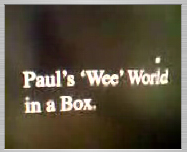
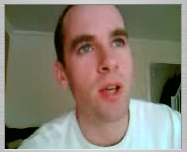
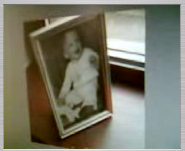
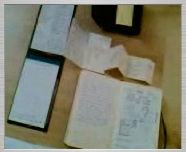
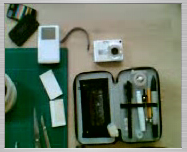


Direction
The intention of this box is to show the processes that I engage
in to help me discover what art means for me and how I can communicate
with it in today’s world. My ten-minute presentation on
Tuesday 4th April proceeded differently from the way I envisaged
it. I thought that there would only be three or four people
present, but there were seven. After giving a short four-minute
introduction, I hoped to walk away from the piece and let the
audience watch the film in the box. As there were more people,
I was forced to stand in front of the audience. With the triptych
lid open it felt a bit like being at Mass, only I was the priest!
(Not sure if I liked that.) What was interesting was the way
we all had to be quiet to hear and be still to see the small
screen.
I now intend to develop the piece more with the box having images
and objects directly or indirectly linked to the audio and video
piece exploring this ‘process’.
References
Hiller, S (2002) After the Freud Museum
Book Works
Morgan, J and Welton, P (1992) See What I Mean? An introduction
to Visual Communication
Arnold